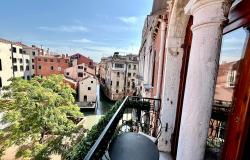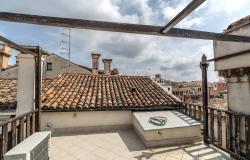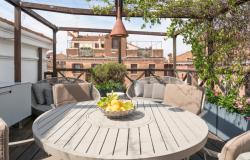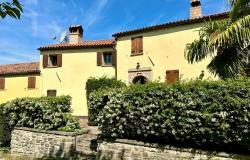Those of us who love Italy for its architecture already know about the great Andrea della Gondola, otherwise known as Palladio, and his many beautiful villas scattered throughout the Veneto. Some iconic villas are so well known that their names will instantly conjure up images of classical proportions and symmetry (the Villa Maser at Asolo, the Villa Rotunda near Vicenza, the Malcontenta on the Brenta Canal…) but very few people have ever heard of the Villa dei Vescovi which actually predates Palladio, and sits so harmoniously in the lush green landscape of the Euganean Hills that it is impossible to imagine the semi-circle of conical hills without its presence.
Built by Giovanni Maria Falconetto between 1535 and 1542 for the archbishops of Padua, it was perhaps the forerunner of the idea of the country house, away from the heat and bustle of city life. The villa was finally bought by the Olcese family in 1962 and subsequently donated to FAI, Fondo Ambiente Italiano, the equivalent organisation to the British National Trust. This is a marvellous opportunity for NT members, as it means that we can visit free of charge throughout the year. (And there are also two beautifully furnished apartments for rent under the eaves where you can imagine yourself as the lord of the manor when the tourists have all gone home.)

The villa is perfect in every way, modest rather than grand, a stately cube of weathered brick and stone with nothing to detract from the view of every side, or from the two loggias looking out from the villa itself. In fact, it probably looks exactly the same today as the day it was built.
You approach though a formal courtyard with a lovely undulating wall, and climb two flights of steps to the entrance. The lower floor must once have been servants’ quarters, but now there is a small snack bar and lots of information about the building, both in English and Italian. Nothing quite prepares you for the piano nobile, the first floor. A wide airy hall allows cool breezes to waft through the villa whilst the brightly frescoed rooms on each side, furnished with antiques, give the impression of a refined home rather than a showcase for tourists, though of course it is that as well. (There are family photos on the side tables, and books line the study walls.) The frescoes were created by a Flemish painter, Lambert Sustris, a great admirer of Raphael. They depict classical scenes, but on the loggias the frescoes are used to create the effect of a garden space, with tendrils and trellises round each of the arches. Here you can sit and while away the hours in comfy wicker chairs, browsing through the art magazines so thoughtfully left for visitors, or simply looking out over the peaceful landscape of vineyards and conical hills.
There is an additional reason just now to visit the Villa dei Vescovi. All summer, and early autumn, the villa is hosting an exhibition of over 100 pieces of contemporary glass made in Murano. Many of the finest artists have contributed pieces, some for sale, which are displayed in every room and in the courtyard too. There is even a (rather ugly, in my view) glass crocodile in a pond in the barchessa.
A depiction of The Last Supper in glass is particularly fascinating. The artist, Silvano Signoretto, has reproduced a table covered in glass food, an exact copy of a fresco in the castle at Trento. It looks so real it could be edible. There are vases in all colours, sculptures, transparent creatures hanging like game birds ready to be eaten, and in the courtyard, just to prove that glass isn’t always fragile, there are discs which can bear your weight if you use them like stepping stones. Mostly the modern glass looks perfectly at home in its renaissance setting, but the two glass chandeliers in the hall (by Fabio Fornasier) seem too heavy and flashy with their spiky 60s design, not quite in keeping with the gracious splendour of the house.
The villa stands on a mound with vineyards on the slopes. Beyond the very tempting shop (with interesting jewellery, bags, books and local produce) is an enoteca where you can taste and buy the prize-winning wines.
This idyllic scene of an ancient villa encircled by green conical hills has remained unchanged for almost 500 years. It’s off the beaten tourist track, and likely to retain all its undiscovered charm for another half millennium.

Further Information:
Villa dei Vescovi: faivescovi@fondoambiente.it
Exhibition: Arte del Vetro Oggi 2016 curated by Jean Blanchaert













